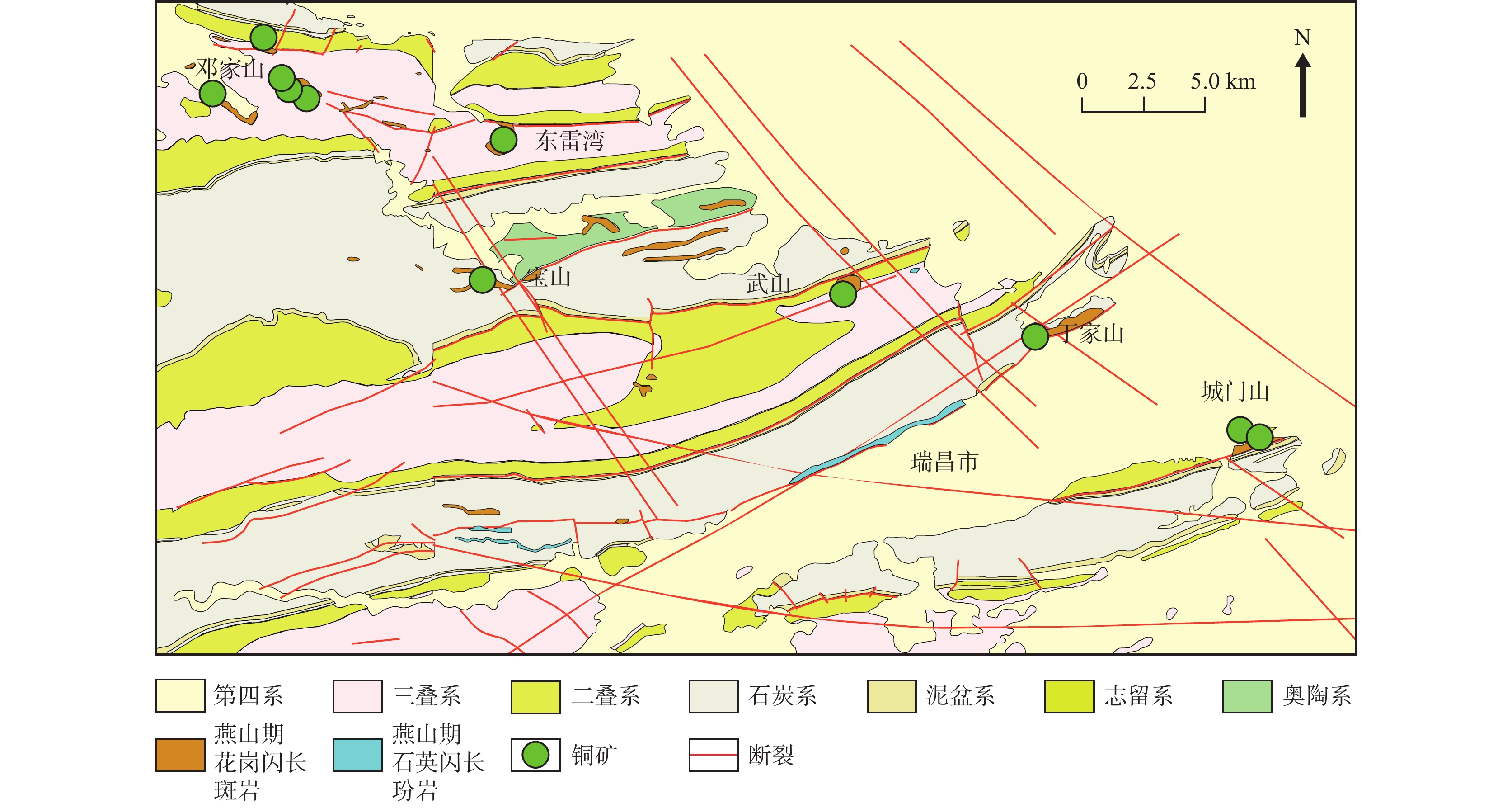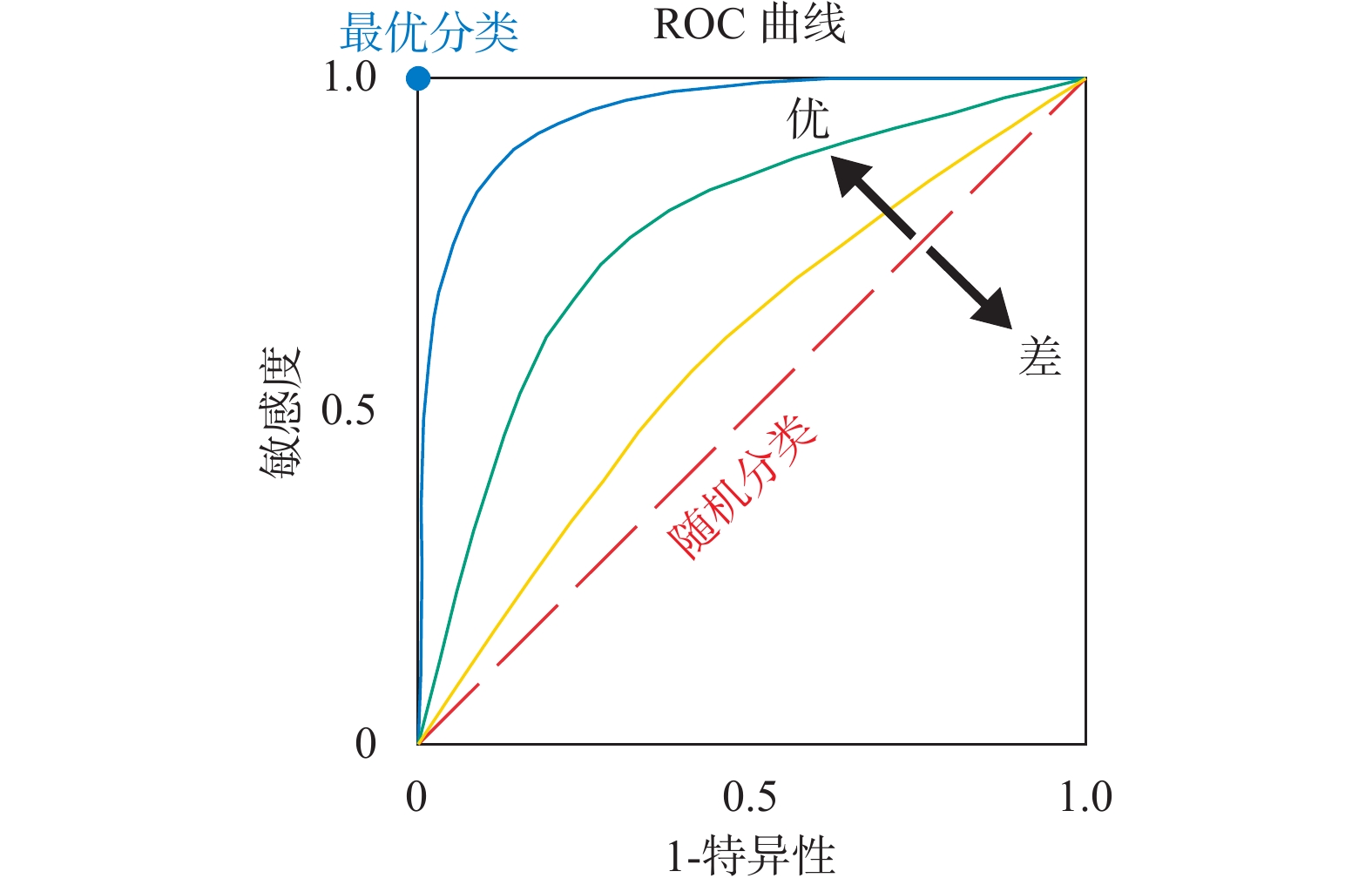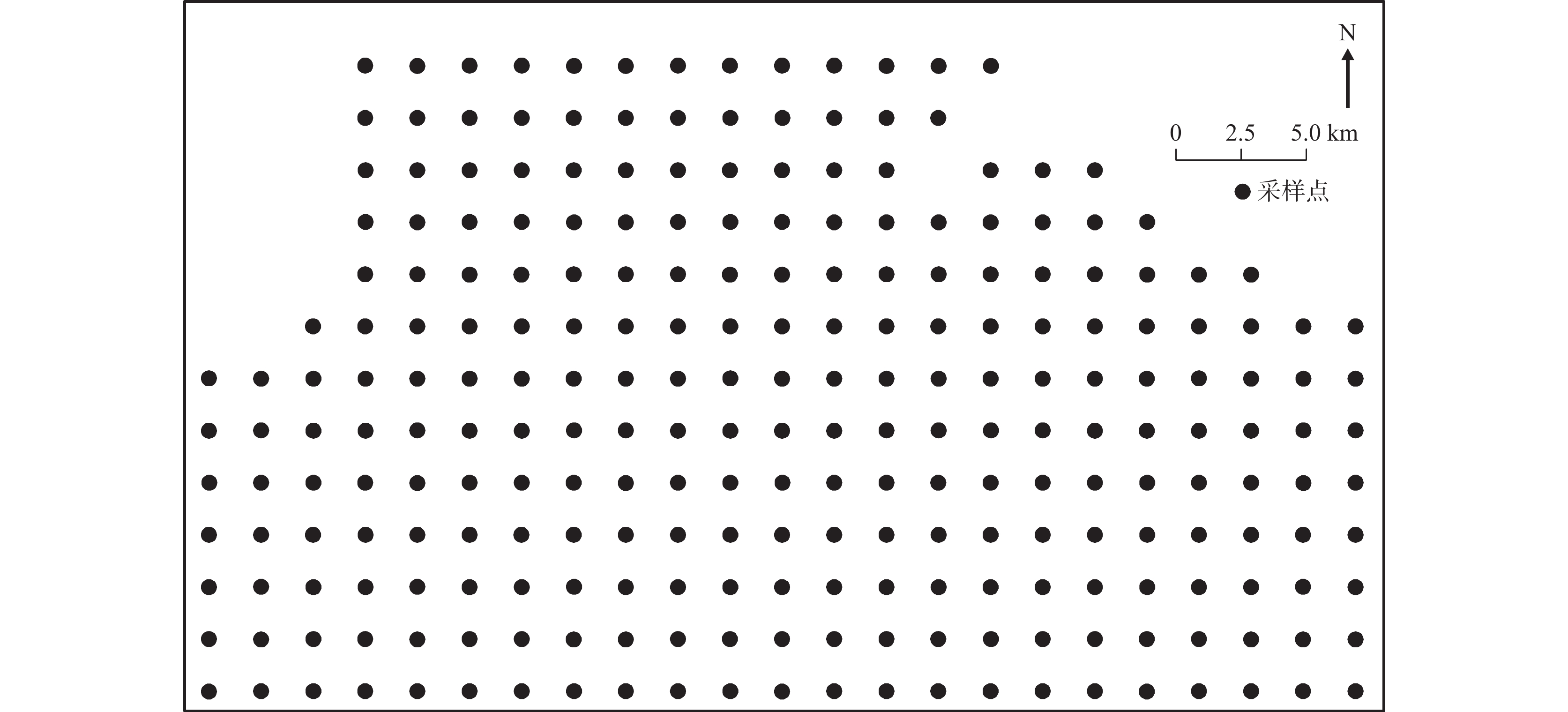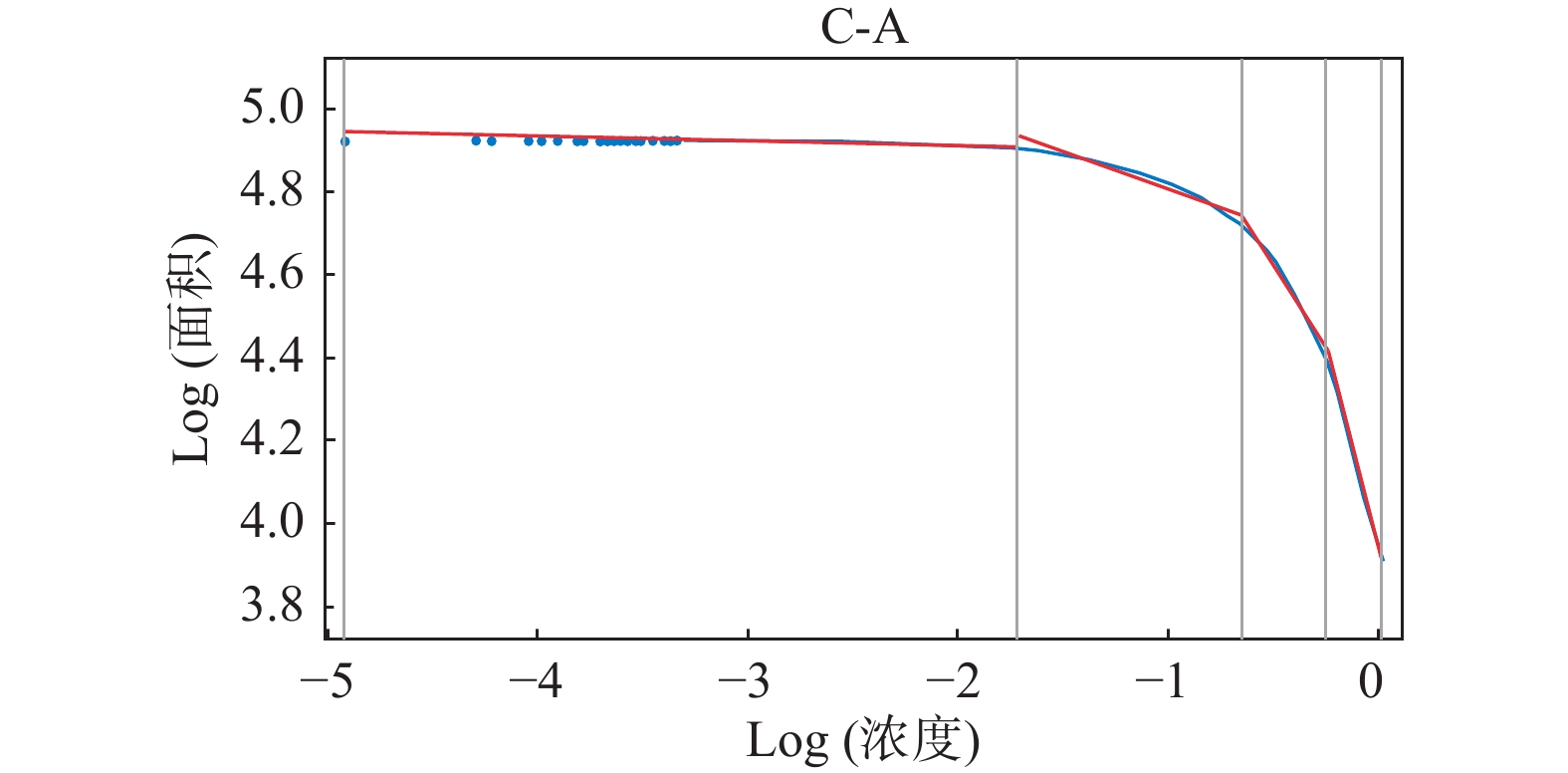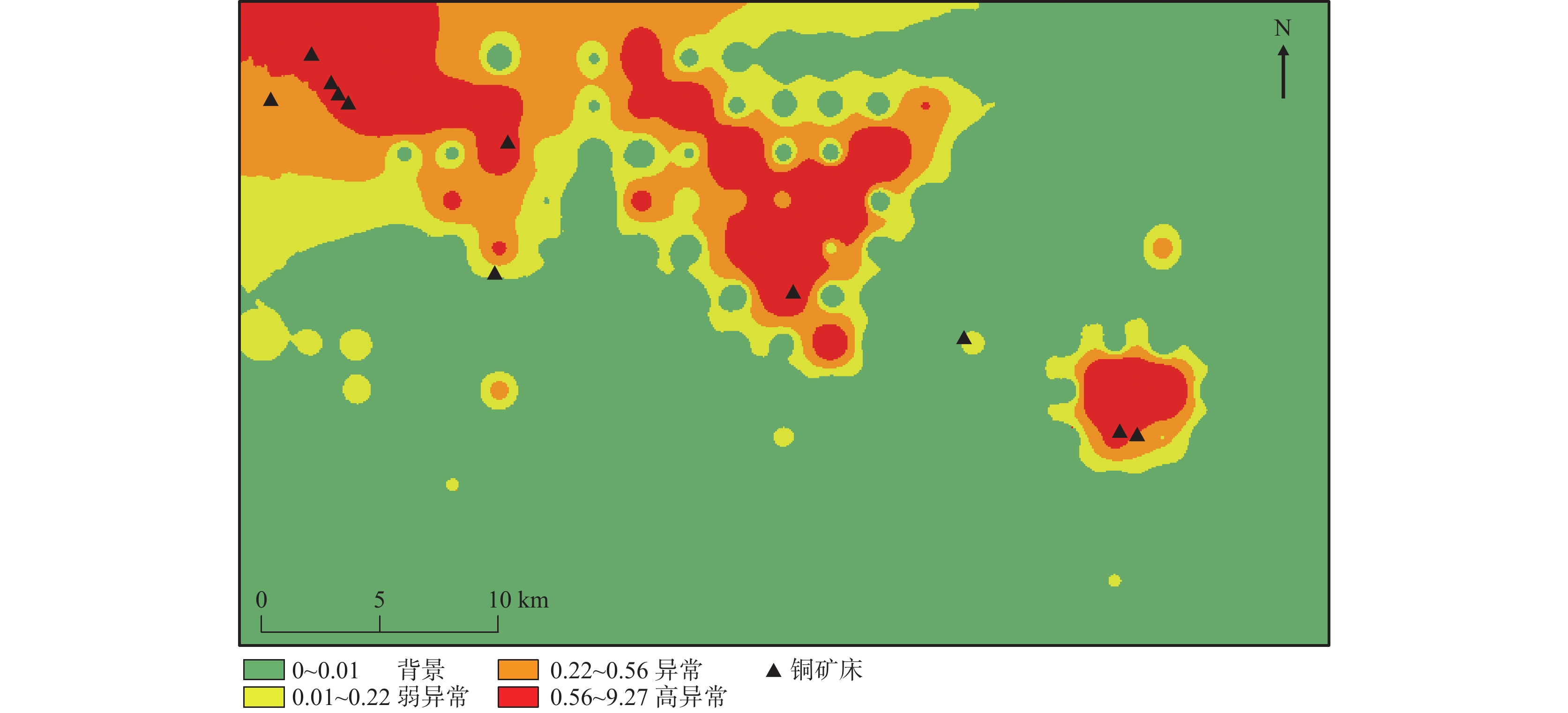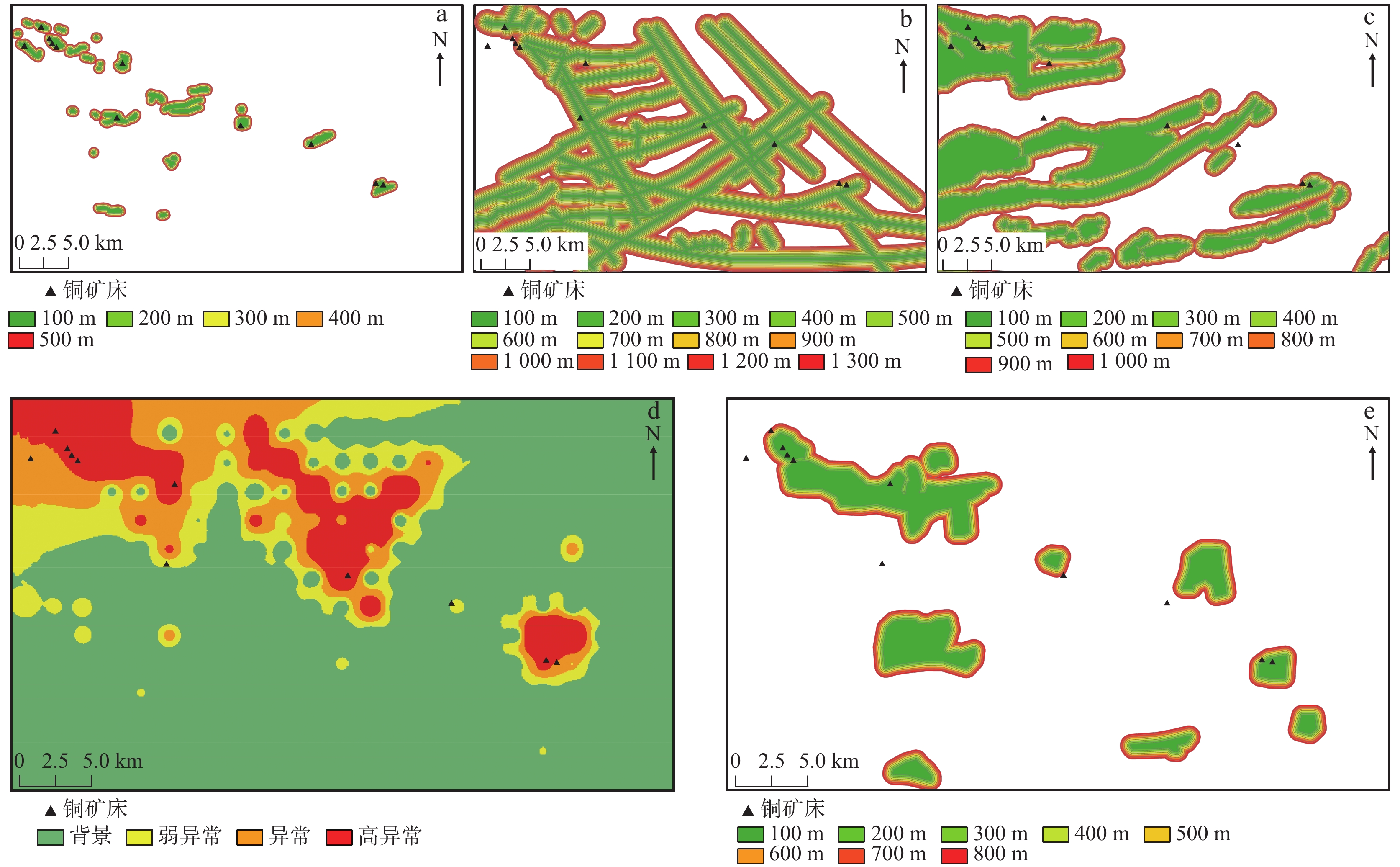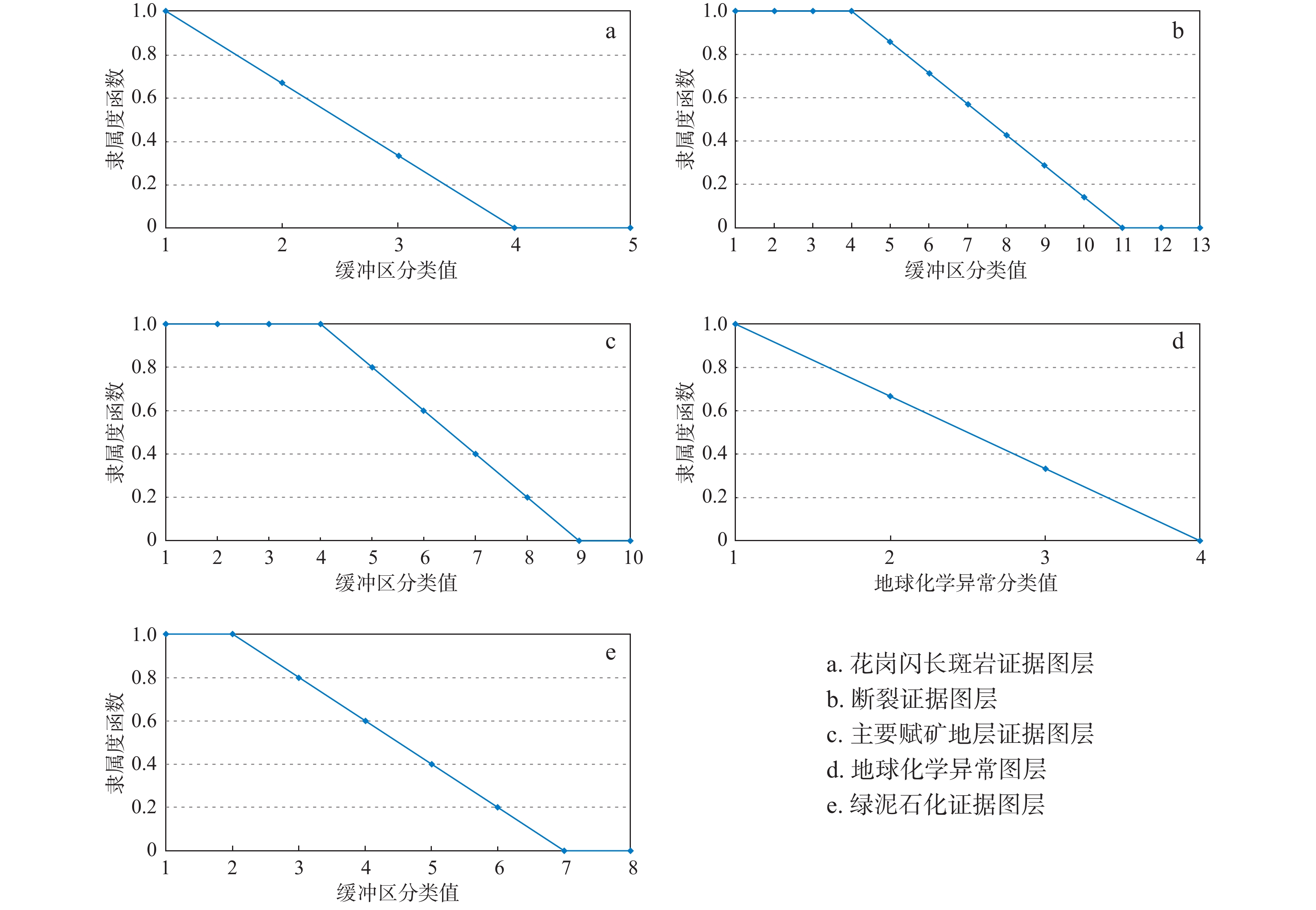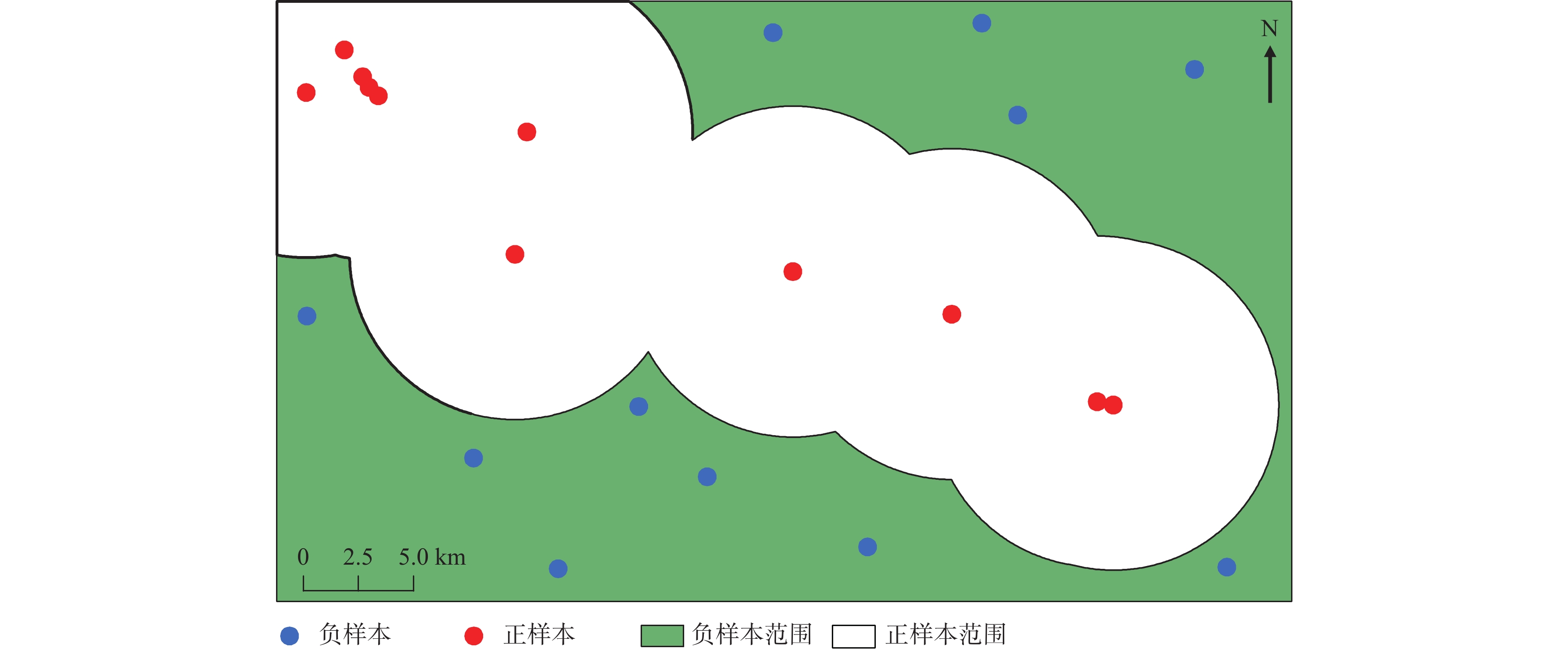Evaluation of Copper Mineral Resource Potential Using Concentration–Area Fractal Model and Fuzzy Evidence Weighting: A Case Study of the Jiurui Region in Jiangxi
-
摘要:
中国江西省的九瑞地区是长江中下游成矿带中最重要的铜矿产地之一,其中花岗闪长斑岩与铜成矿关系密切。基于水系沉积物与矿化相关的信息,采用因子分析(FA)、浓度–面积分形法(C–A)和模糊证据权方法(FWofE)相结合建立成矿潜力预测模型。使用因子分析处理包含32个元素的255份水系沉积物样本数据,找到能够指示铜矿化的组合元素(即主因子)。采用多重分形反距离加权插值法(MIDW)创建主因子得分栅格图并用C–A分形模型提取与铜矿化相关的地化异常。将得到和铜矿化相关的地球化学异常图与地质、遥感解译数据相结合,应用模糊证据权方法建立预测模型。结果表明:已知铜矿床位于圈定预测概率高值区,且受花岗闪长斑岩和断裂的分布共同控制;除已知铜矿床区域外,圈定的3个一级远景区域内也具有较高的概率,值得进一步铜勘查找矿工作的进行。
Abstract:The Jiurui region in Jiangxi Province, China, is one of the most significant copper mining areas in the middle and lower reaches of the Yangtze River mineralization belt, with a close relationship between granodiorite porphyry and copper mineralization. In this study, a predictive model for mineralization potential was established by combining factor analysis (FA), concentration-area (C-A) fractal method, and fuzzy weight of evidence (FWofE) based on information related to stream sediment and mineralization. ϕfactor analysis was applied to a dataset of 255 stream sediment samples containing 32 elements to identify combinations of elements (principal factors) indicative of copper mineralization. κ the principal factor scores were interpolated using the multiple inverse distance weighted (MIDW) method to create a raster map, and the C-A fractal model was employed to extract geochemical anomalies associated with copper mineralization. λ the geochemical anomaly map related to copper mineralization was integrated with geological and remote sensing interpretation data, and a predictive model was established using the fuzzy weight of evidence method. The results indicated that: known copper deposits are located within high-probability zones defined by the model and are influenced by the distribution of granodiorite porphyry and faults; in addition to the known copper deposit areas, three primary prospective areas identified within the defined regions also exhibit a high probability, meriting further exploration efforts for copper prospecting.
-

-
图 1 长江中下游成矿带简易地质图(据Pan et al.,1999修)
Figure 1.
图 2 九瑞铜矿区地质图(据Yang et al.,2011修)
Figure 2.
表 1 32种元素的检出限表
Table 1. Detection limits of 32 elements
序号 元素 检出限 序号 元素 检出限 1 Ag 0.01 17 Mo 0.5 2 As 2.82 18 Nb 5 3 Au 0.0003 19 Ni 5 4 B 5 20 P 30 5 Ba 10 21 Pb 5.4 6 Be 0.5 22 Sb 0.2 7 Bi 0.16 23 Sn 0.14 8 Cd 0.1 24 Sr 5 9 Co 1 25 Th 5.1 10 Cr 7.2 26 Ti 30 11 Cu 1 27 U 1 12 F 13 28 V 2 13 Hg 0.01 29 W 0.5 14 La 10 30 Y 10 15 Li 5 31 Zn 10 16 Mn 30 32 Zr 10 注:元素含量为10-6。 表 2 R型因子分析的正交旋转因子载荷矩阵表
Table 2. Orthometric rotating factor loading matrix for R-factor analysis
变量 因子载荷 F1 F2 F3 F4 F5 F6 F7 Ag 0.101 −0.031 0.954 −0.065 0.030 0.039 −0.062 As 0.059 0.329 −0.099 0.854 −0.039 −0.027 −0.203 Au −0.012 0.717 −0.041 0.007 −0.026 0.005 −0.069 B −0.303 −0.072 −0.021 −0.072 0.716 0.163 −0.104 Ba 0.101 −0.031 0.954 −0.065 0.030 0.039 −0.062 Be 0.910 −0.023 0.175 0.068 0.015 0.170 −0.016 Bi −0.025 0.941 −0.006 0.062 −0.017 −0.032 0.007 Cd 0.055 0.249 −0.098 0.917 −0.099 −0.014 0.102 Co 0.767 −0.006 0.093 0.435 0.224 −0.021 −0.112 Cr 0.831 0.001 0.007 −0.061 −0.013 0.082 0.036 Cu −0.089 0.786 0.022 0.324 −0.022 0.014 0.288 F 0.835 0.043 −0.057 −0.051 −0.087 0.102 0.123 Hg 0.063 0.221 0.023 0.196 0.100 0.173 −0.443 La 0.235 −0.093 0.068 −0.125 0.153 0.760 0.047 Li 0.890 −0.019 0.124 0.013 0.059 0.177 −0.038 Mn 0.489 0.005 0.065 0.328 0.198 0.016 −0.212 Mo −0.009 0.489 0.015 0.229 0.015 0.044 0.679 Nb 0.254 0.104 0.118 −0.045 0.611 0.123 0.029 Ni 0.875 −0.069 0.049 −0.070 −0.026 0.181 0.052 P 0.464 −0.049 0.417 0.025 −0.226 −0.218 0.100 Pb 0.075 0.918 −0.014 0.050 −0.002 −0.026 −0.157 Sb 0.048 0.926 −0.062 0.169 0.022 −0.059 −0.053 Sn 0.274 0.287 0.064 0.053 −0.094 0.572 0.068 Sr 0.209 0.058 0.736 −0.077 −0.411 −0.093 0.068 Th 0.332 −0.015 −0.241 0.010 0.603 −0.116 0.094 Ti 0.569 0.011 0.586 0.006 0.252 −0.002 −0.110 U 0.170 −0.022 −0.193 −0.058 0.073 0.089 0.289 V 0.931 0.042 0.146 0.049 0.036 0.134 0.032 W −0.077 0.657 0.171 0.144 0.064 −0.022 0.444 Y 0.108 −0.216 −0.181 0.031 0.152 0.739 −0.141 Zn 0.026 0.049 −0.017 0.959 −0.055 −0.023 0.041 Zr −0.570 −0.070 −0.166 −0.098 0.546 0.097 0.007 注:该因子分析采用的提取方法为主成分分析法,旋转方法为Kaiser标准化最大方差法,旋转在七次迭代后已经收敛。 表 3 各证据层隶属度表(MSF)及模糊证据权重计算表
Table 3. Table of membership of each evidence layer (MSF) and calculation of fuzzy weights of evidence
缓冲距离分类 主要赋矿地层 断裂 花岗闪长斑岩 绿泥石化蚀变 地球化学异常分类 C-A分形模型 分类值 缓冲
距离(m)隶属度 证据
权重隶属度 证据
权重隶属度 证据
权重隶属度 证据
权重分类值 C-A分形 隶属度 证据
权重1 100 1 0.60 1 0.37 1 4.06 1 2.05 1 高异常 1 2.06 2 200 1 0.60 1 0.37 0.67 3.46 1 2.05 2 异常 0.67 2.00 3 300 1 0.60 1 0.37 0.33 2.64 0.8 1.99 3 弱异常 0.33 1.83 4 400 1 0.60 1 0.37 0 0.69 0.6 1.91 4 背景 −0.37 −0.37 5 500 0.8 0.58 0.86 0.36 0 0.69 0.4 1.78 5 − − − 6 600 0.6 0.55 0.71 0.36 − − 0.2 1.56 6 − − − 7 700 0.4 0.38 0.57 0.35 − − 0 1.03 7 − − − 8 800 0.2 −0.03 0.43 0.34 − − 0 1.03 8 − − − 9 900 0 −0.03 0.29 0.32 − − − − 9 − − − 10 1000 0 − 0.14 0.30 − − − − 10 − − − 11 1100 − − 0 0.26 − − − − 11 − − − 12 1200 − − 0 0.26 − − − − 12 − − − 13 1300 − − 0 0.26 − − − − 13 − − − 注:“−”为空值。 -
[1] 陈风河, 王建兴, 董国明, 等. 模糊证据权法在承德多金属矿产资源预测中的应用[J]. 新疆有色金属, 2015, 38(2): 76-78+82
CHEN Fenghe, WANG Jianxing, DONG Guoming, et al. Application of fuzzy weight of evidence method in prediction of polymetallic mineral resources in Chengde[J]. Xinjiang Nonferrous Metals, 2015, 38(2): 76-78+82.
[2] 成秋明, 陈志军, Ali Khaled. 模糊证据权方法在镇沅(老王寨)地区金矿资源评价中的应用[J]. 地球科学(中国地质大学学报), 2007, 32(2): 175-184
CHENG Qiuming, CHEN Zhijun, Ali Khaled. Application of Fuzzy Weigh of Evidence Method in Mineral Resource Assessment for Gold in Zhenyuan District, Yunnan Province, China[J]. Earth Science (Journal of China University of Geosciences), 2007, 32(2): 175-184.
[3] 邓军, 战明国, 周伟金, 等. 基于模糊证据权法的广西典型金矿矿产定量预测[J]. 地质力学学报, 2021, 27(3): 374-390
DENG Jun, ZHAN Mingguo, ZHOU Weijin, et al. Quantitative prediction of mineral resources in typical gold deposits in Guangxi, China using a fuzzy weights of evidence method[J]. Chinese Journal of Geomechanics, 2021, 27(3): 374-390.
[4] 董庆吉, 陈建平, 唐宇. R型因子分析在矿床成矿预测中的应用——以山东黄埠岭金矿为例[J]. 地质与勘探, 2008, 44(4): 64-68
DONG Qingji, CHEN Jianping, TANG Yu. Application of R type Factor Analyses in Mineralization prognosis: by an example of Huangbuling Gold deposit, Shandong province[J]. Geology and Exploration, 2008, 44(4): 64-68.
[5] 黄鑫怀, 李红利, 李增华, 等. 基于模糊证据权法的江西相山盆地火山岩型铀矿成矿潜力评价[J]. 世界核地质科学, 2023, 40(2): 226-235 doi: 10.3969/j.issn.1672-0636.2023.02.009
HUANG Xinghuai, LI Hongli, LI Zenghua, et al. Application of fuzzy weights of evidence method to prediction of mineralization in the volcanic-type uranium deposit in Xiangshan basin, Jiangxi[J]. World Nuclear Geology, 2023, 40(2): 226-235. doi: 10.3969/j.issn.1672-0636.2023.02.009
[6] 黄秀, 张钊, 陈建平, 等. 混合模糊证据权模型在河北承德煤炭资源预测中的应用[J]. 地质通报, 2010, 29(7): 1075-1081
HUANG Xiu, ZHANG Zhao, CHEN Jianping, et al. Application of hybrid fuzzy weights of evidence model in mineral resource assessment for coal in Chengde area, Hebei, China[J]. Geological Bulletin of China, 2010, 29(7): 1075-1081.
[7] 霍雨佳. 基于模糊证据权的川滇相邻地区铜矿预测[D]. 吉林: 吉林大学, 2023
HUO Yujia. Prediction of Copper Minerals in Sichuan-Yunnan Adjacent Region based on Fuzzy Evidence Weight [D]. Jilin: Jilin University, 2023.
[8] 蒋少涌, 徐耀明, 朱志勇, 等. 九瑞矿集区燕山期构造-岩浆作用及其与铜金多金属成矿关系研究[J]. 岩石学报, 2013, 29(12): 4051-4068
JIANG Shaoyong, XU Yaoming, ZHU Zhiyong, et al. Study on Mesozoic tectonics and granitic magmatism and their relationship with Cu-Au mineralization in the Jiurui ore district, Jiangxi province[J]. Acta Petrologica Sinica, 2013, 29(12): 4051-4068.
[9] 孔凡斌. 江西九瑞铜多金属矿深部成矿规律与找矿预测研究[D]. 南京: 南京大学, 2014
KONG Fanbin. Deep copper polymetallic metallogenic regularities and prospecting studies of favorable locations in Jiurui region of Jiangxi province[D]. Nanjing: Nanjing University, 2014.
[10] 李文明, 刘拓, 孙吉明, 等. 新疆北山白山地区地球化学特征及找矿远景预测[J]. 西北地质, 2021, 54(4): 42-48
LI Wenming, LIU Tuo, SUN Jiming, et al. Geochemical Characteristics and Prospecting Prognosis in Baishan Area of Xinjiang Beishan[J]. Northwestern Geology, 2021, 54(4): 42-48.
[11] 欧阳渊, 刘洪, 李光明, 等. 基于随机森林算法的找矿预测——以冈底斯成矿带西段斑岩−浅成低温热液型铜多金属矿为例[J].中国地质, 2023, 50(2): 303−330.
OUYANG Yuan, LIU Hong, LI Guangming, et al. 2023. Mineral search prediction based on Random Forest algorithm: A case study on porphyry-epithermal copper polymetallic deposits in the western Gangdise meatallogenic belt[J]. Geology in China, 2023, 50(2): 303−330.
[12] 所颖萍. 江西九瑞地区成矿时空结构与铜金成矿作用[D]. 南京: 南京大学, 2013
SUO Yingping. The Metallogensis and space-time structure of copper and gold in Jiurui district, Jiangxi province[D]. Nanjing: Nanjing University, 2013.
[13] 王佳营, 曾威, 张祺, 等. 模糊证据权方法在纳米比亚白岗岩型铀矿预测中的应用[J]. 地质通报, 2023, 42(8): 1318-1333
WANG Jiaying, ZENG Wei, ZHANG Qi, et al. Application of fuzzy weights of evidence method in metallogenic prediction for alaskite-type uranium deposits in Namibia[J]. Geological Bulletin of China, 2023, 42(8): 1318-1333.
[14] 王兆强, 张岩. 长江中下游成矿带鸡笼山矽卡岩型铜金钼矿床花岗闪长斑岩对成岩-成矿的指示: 来自地球化学和锆石U-Pb年龄的证据[J]. 地质通报, 2023, 42(9): 1480−1493.
WANG Zhaoqiang, ZHANG Yan. Geochemistry and zircon U-Pb age of granodiorite porphyry: Constraints on diagenetic and metallogenic processes of the Jilongshan Cu-Au-Mo deposit, Middle-Lower Yangtze River Valley Metallogenic Belt, China[J]. Geological Bulletin of China, 2023, 42(9): 1480−1493.
[15] 武进. 基于模糊证据权的找矿远景区预测方法研究与应用-以西藏米拉山为例[D]. 成都: 成都理工大学, 2017
WU Jin. Research and application of the forecasting method based on fuzzy evidence right in the search for distant scenic spot-Mila mountain as an example[D]. Chengdu: Chengdu University of Technology, 2017.
[16] 徐耀明. 江西九瑞矿集区燕山期岩浆岩成岩成矿作用地球化学及矿床预测研究[D]. 南京: 南京大学, 2014
XU Yaoming. Geochemistry of late Mesozoic magmatic rocks and related mineralizations and mineral prospecting in the Jiurui district of Jiangxi province[D]. Nanjing: Nanjing University, 2014.
[17] 薛琮一, 王嘉伟, 杨征, 等. 新疆和田布雅煤矿一带水系沉积物测量地球化学特征及找矿方向[J]. 西北地质, 2020, 53(4): 66-72
XUE Congyi, WANG Jiawei, YANG Zheng, et al. A Review of Geochemical Characteristics and Prospecting Direction of Stream Sediment of Buya Coal Mine in Hetian, Xinjiang[J]. Northwestern Geology, 2020, 53(4): 66-72.
[18] 张津瑞, 陈华, 任军平, 等. 矿产资源潜力评价方法对比及其发展趋势探讨[J]. 西北地质, 2023, 56(2): 292-305.
ZHANG Jinrui, CHEN Hua, REN Junping, et al. Mineral Resource Assessment Methods Comparison and Its Development Trend Discussion[J]. Northwestern Geology, 2023, 56(2): 292-305.
[19] 周光锋. 基于机器学习的个旧地区锡铜多金属矿成矿预测[D]. 北京: 中国地质大学(北京), 2021
ZHOU Guangfeng. Mapping mineral prospectivity for Tin-Copper polymetallic mineralization by maschine learning methods in Gejiu, Yunnan province, China[D]. Beijing: China University of Geosciences (Beijing), 2021.
[20] Agterberg F P. Computer Programs for Mineral Exploration[J]. Science, 1989, 245(4913): 76–81. doi: 10.1126/science.245.4913.76
[21] Agterberg F P, Bonham-Carter G F. Statistical applications in the earth sciences[M]. Canada: Geological Survey of Canada, 1990.
[22] Agterberg F P, Bonharn-Carter G F. Weights of Evidence Modeling And Weighted Logistic Regression For Mineral Potential Mapping[M]. New York: Oxford University Press, 1994.
[23] Ali K, Cheng Q M, Chen Z J. Multifractal power spectrum and singularity analysis for modelling stream sediment geochemical distribution patterns to identify anomalies related to gold mineralization in Yunnan Province, South China[J]. Geochemistry: Exploration, Environment, Analysis, 2007, 7(4): 293-301. doi: 10.1144/1467-7873/06-116
[24] Ayres R U, Ayres L W, Råde I. The Life Cycle of Copper, Its Co-Products and Byproducts[M]. Dordrecht: Springer Netherlands, 2003.
[25] Carranza E J M. Geochemical anomaly and mineral prospectivity mapping in GIS[M]. Boston: Elsevier, 2009.
[26] Chauhan S, Sharma M, Arora M K, et al. Landslide Susceptibility Zonation through ratings derived from Artificial Neural Network[J]. International Journal of Applied Earth Observation and Geoinformation, 2010, 12(5): 340–350. doi: 10.1016/j.jag.2010.04.006
[27] Chen Y L, Wu W. A prospecting cost-benefit strategy for mineral potential mapping based on ROC curve analysis[J]. Ore Geology Reviews, 2016, 74: 26–38. doi: 10.1016/j.oregeorev.2015.11.011
[28] Cheng Q M. GeoData Analysis System (GeoDAS) for mineral exploration: user’s guide and exercise manual[C] .Canada: Material for the training workshop on GeoDAS held at York University, 2000.
[29] Cheng Q M. A New Model for Quantifying Anisotropic Scale Invariance and for Decomposition of Mixing Patterns[J]. Mathematical Geology, 2004, 36(3): 345–360. doi: 10.1023/B:MATG.0000028441.62108.8a
[30] Cheng Q M. Mapping singularities with stream sediment geochemical data for prediction of undiscovered mineral deposits in Gejiu, Yunnan Province, China[J]. Ore Geology Reviews, 2007, 32(1–2): 314–324. doi: 10.1016/j.oregeorev.2006.10.002
[31] Cheng Q M. Non-Linear Theory and Power-Law Models for Information Integration and Mineral Resources Quantitative Assessments[J]. Mathematical Geosciences, 2008a, 40(5): 503–532. doi: 10.1007/s11004-008-9172-6
[32] Cheng Q M. Modeling Local Scaling Properties for Multiscale Mapping[J]. Vadose Zone Journal, 2008b, 7(2): 525–532. doi: 10.2136/vzj2007.0034
[33] Cheng Q M. Multifractal interpolation method for spatial data with singularities[J]. Journal of the Southern African Institute of Mining and Metallurgy, 2015, 115(3): 235-240. doi: 10.17159/2411-9717/2015/v115n3a9
[34] Cheng Q M, Agterberg F P. Fuzzy weights of evidence method and its application in mineral potential mapping[J]. Natural Resources Research, 1999, 8(1): 27-35. doi: 10.1023/A:1021677510649
[35] Cheng Q M, Agterberg F P, Ballantyne S B. The separation of geochemical anomalies from background by fractal methods[J]. Journal of Geochemical Exploration, 1994, 51(2): 109–130. doi: 10.1016/0375-6742(94)90013-2
[36] Cheng Q M, Zhang S Y. Fuzzy weights of evidence method implemented in GeoDAS GIS for information extraction and integration for prediction of point events[C]. Toronto: International Geoscience and Remote Sensing Symposium, 2002, 5: 2933-2935.
[37] Egan J P. Signal detection theory and ROC-analysis[M]. New York: Academic Press, 1975.
[38] Fabrigar L R, Wegener D T, MacCallum R C, et al. Evaluating the use of exploratory factor analysis in psychological research. [J]. Psychological Methods, 1999, 4(3): 272–299. doi: 10.1037/1082-989X.4.3.272
[39] Hassanpour S, Afzal P. Application of concentration–number (C–N) multifractal modeling for geochemical anomaly separation in Haftcheshmeh porphyry system, NW Iran[J]. Arabian Journal of Geosciences, 2013, 6(3): 957–970. doi: 10.1007/s12517-011-0396-2
[40] HUO Yujia, WANG Yongzhi, WU Qinghua, et al. Analysis method of gold reserve mineral deposit in Yunnan Province based on fuzzy evidence weight[J]. Progress in Geophysics, 2022, 37(6): 2552-2561.
[41] Xiao F, Wang K Q, Hou W S, et al. Prospectivity Mapping for Porphyry Cu–Mo Mineralization in the Eastern Tianshan, Xinjiang, Northwestern China[J]. Natural Resources Research, 2020, 29(1): 89–113. doi: 10.1007/s11053-019-09486-5
[42] Yang S Y, Jang S Y, Li L, et al. Late Mesozoic magmatism of the Jiurui mineralization district in the Middle–Lower Yangtze River Metallogenic Belt, Eastern China: Precise U–Pb ages and geodynamic implications[J]. Gondwana Research, 2011, 20(4): 831-843. doi: 10.1016/j.gr.2011.03.012
[43] Keller C P. Geographic information systems for geoscientists: Modelling with GIS[J]. Computers & Geosciences, 1995, 21(9): 1110-1112.
[44] Li H L, Li Z H, Ouyang Y P, et al. Application of principal component analysis and a spectrum-area fractal model to identify geochemical anomalies associated with vanadium mineralization in northeastern Jiangxi Province, South China[J]. Geochemistry: Exploration, Environment, Analysis, 2022, 22(3): 2021-090.
[45] Mandelbrot B B. The fractal geometry of nature[M]. Deutschland: W. H. Freeman and Company, 1982.
[46] Mudd G. M. , Jowitt S. M. Growing Global Copper Resources, Reserves and Production: Discovery Is Not the Only Control on Supply[J]. Economic Geology, 2018, 113(6): 1235-1267. doi: 10.5382/econgeo.2018.4590
[47] Nykänen V. Radial Basis Functional Link Nets Used as a Prospectivity Mapping Tool for Orogenic Gold Deposits Within the Central Lapland Greenstone Belt, Northern Fennoscandian Shield[J]. Natural Resources Research, 2008, 17(1): 29-48. doi: 10.1007/s11053-008-9062-0
[48] Nykänen V, Lahti I, Niiranen T, et al. Receiver operating characteristics (ROC) as validation tool for prospectivity models — A magmatic Ni–Cu case study from the Central Lapland Greenstone Belt, Northern Finland[J]. Ore Geology Reviews, 2015, 71: 853-860. doi: 10.1016/j.oregeorev.2014.09.007
[49] Pan Y M, Dong P. The Lower Changjiang (Yangzi/Yangtze River) metallogenic belt, east central China: intrusion- and wall rock-hosted Cu–Fe–Au, Mo, Zn, Pb, Ag deposits[J]. Ore Geology Reviews, 1999, 15(4): 177-242. doi: 10.1016/S0169-1368(99)00022-0
[50] Parsa M, Maghsoudi A, Yousefi M, et al. Multifractal interpolation and spectrum–area fractal modeling of stream sediment geochemical data: Implications for mapping exploration targets[J]. Journal of African Earth Sciences, 2017, 128: 5-15. doi: 10.1016/j.jafrearsci.2016.11.021
[51] Porwal A, Carranza E J M, Hale M. A Hybrid Fuzzy Weights-of-Evidence Model for Mineral Potential Mapping[J]. Natural Resources Research, 2006, 15(1): 1-14 . doi: 10.1007/s11053-006-9012-7
[52] Rossi M, Guzzetti F, Reichenbach P, et al. Optimal landslide susceptibility zonation based on multiple forecasts[J]. Geomorphology, 2010, 114(3): 129-142. doi: 10.1016/j.geomorph.2009.06.020
[53] Swets J A. Signal Detection Theory and ROC Analysis in Psychology and Diagnostics Psychology Press[M]. New York: Psychology Press, 2014.
[54] Zhang D J, Agterberg F, Cheng Q M, et al. A Comparison of Modified Fuzzy Weights of Evidence, Fuzzy Weights of Evidence, and Logistic Regression for Mapping Mineral Prospectivity[J]. Mathematical Geosciences, 2014, 46(7): 869-885. doi: 10.1007/s11004-013-9496-8
[55] Zhang Z J, Zuo R G, Xiong Y H. A comparative study of fuzzy weights of evidence and random forests for mapping mineral prospectivity for skarn-type Fe deposits in the southwestern Fujian metallogenic belt, China[J]. Science China Earth Sciences, 2016, 59(3): 556-572. doi: 10.1007/s11430-015-5178-3
[56] Zheng Y Y, Sun X, Gao S B, et al. Analysis of stream sediment data for exploring the Zhunuo porphyry Cu deposit, southern Xizang[J]. Journal of Geochemical Exploration, 2014, 143: 19-30. doi: 10.1016/j.gexplo.2014.02.012
[57] Zou K H, O’Malley A J, Mauri L. Receiver-Operating Characteristic Analysis for Evaluating Diagnostic Tests and Predictive Models[J]. Circulation, 2007, 115(5): 654-657. doi: 10.1161/CIRCULATIONAHA.105.594929
[58] Zuo R G, Carranza E J M, Cheng Q. Fractal/multifractal modelling of geochemical exploration data[J]. Journal of Geochemical Exploration, 2012, 122: 1-3. doi: 10.1016/j.gexplo.2012.09.009
[59] Zuo R G, Xia Q L, Zhang D J. A comparison study of the C–A and S–A models with singularity analysis to identify geochemical anomalies in covered areas[J]. Applied Geochemistry, 2013, 33: 165-170. doi: 10.1016/j.apgeochem.2013.02.009
-




 下载:
下载:
